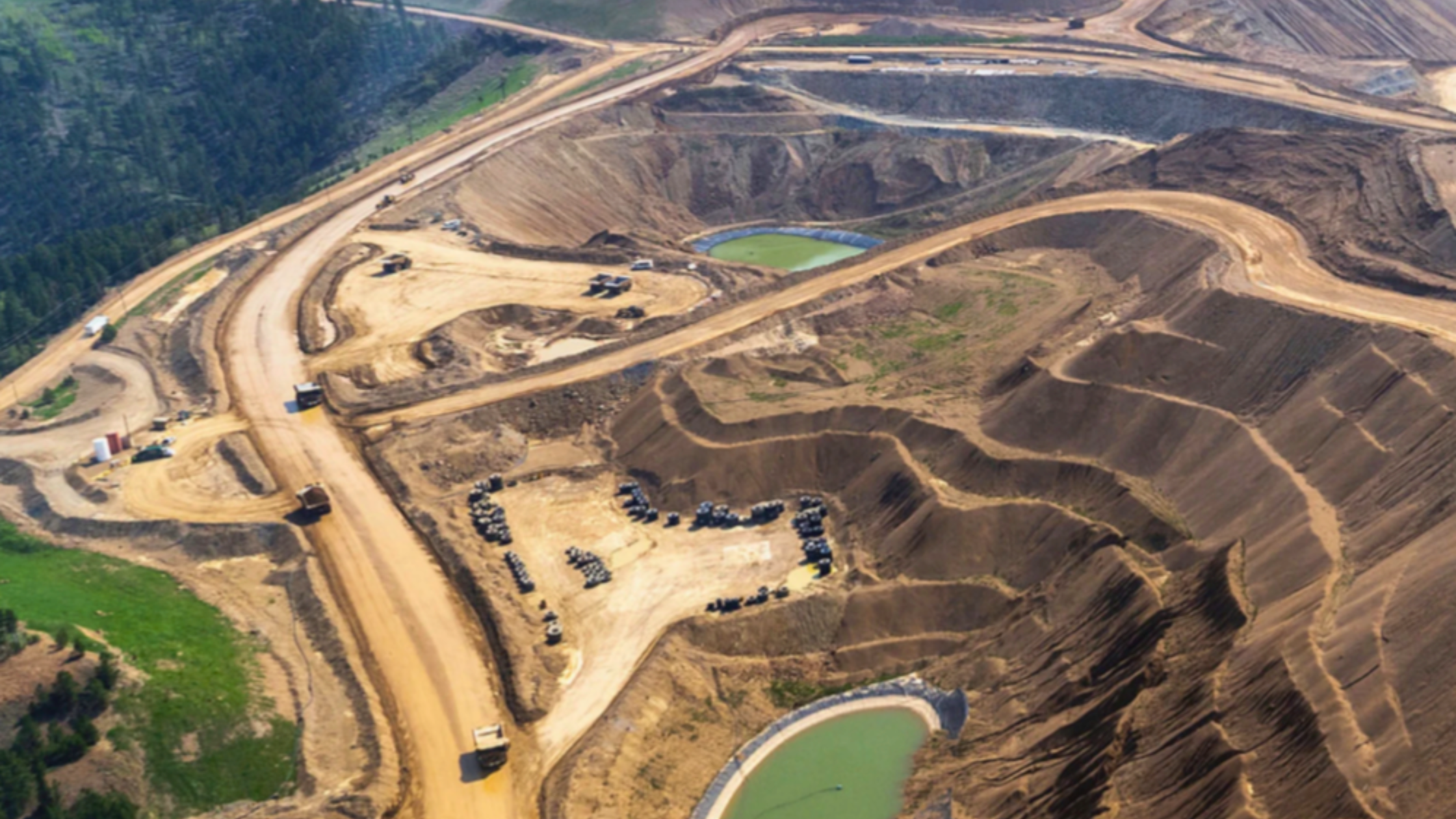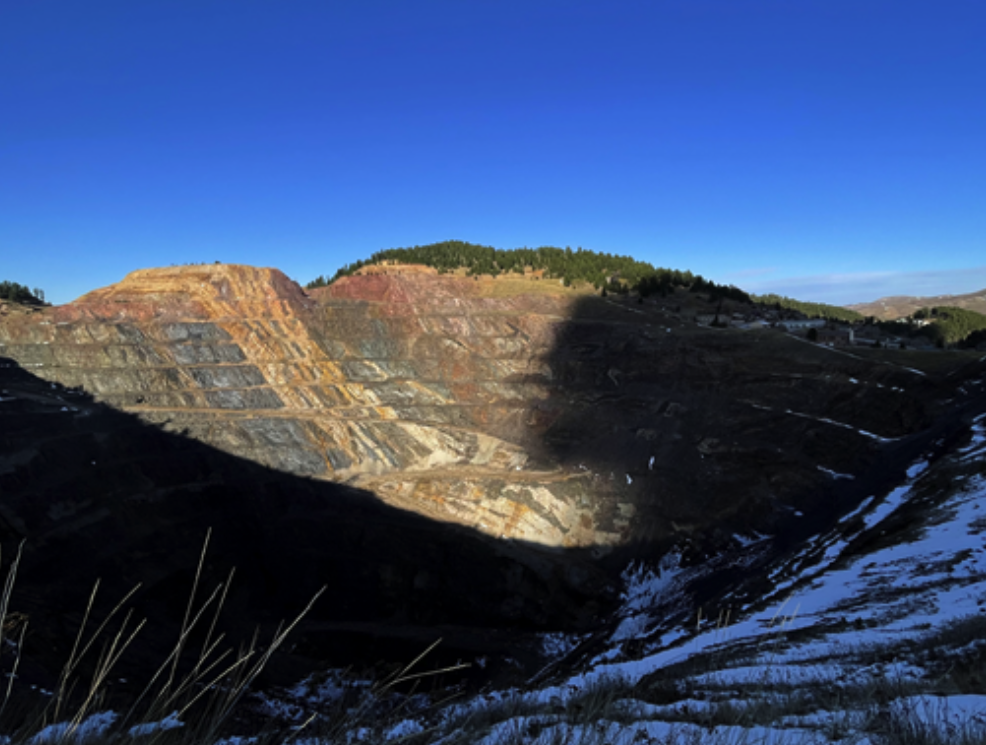Exploiting the Black Hills (Again)
By Erika Pietrzak, September 30, 2025
Gold mining is once again threatening the sacred Black Hills, putting water, ecosystems, and Lakota culture at risk. Despite treaties and court rulings, corporations still push to carve open this ancestral land for profit.
The Black Hills–or Paha Sápa–are a sacred place for the Lakota people used for hunting and spiritual practices. The Paha Sápa roughly translates to “hills that are black”, named by the Lakota people for the dark pines that engulf the slopes. The land is rich in wildlife and natural resources, which started attracting colonizers in the 18th century and has held the interest of the American government ever since. The Lakota have lived on this sacred land for thousands of years, practicing important cultural traditions that are deeply centered on the surrounding environment.
Gold is one of the resources that attracted colonizers, which led to the gold rush of the mid-to-late 1800s. This resulted in multiple gold mines being developed across the Black Hills, many of which are still operating today. Gold mining is particularly harmful to the environment due to its reliance on toxic chemicals to separate gold from other metals, which pollute nearby ecosystems and communities generate significant quantities of waste. Attempting to gain access to gold, American corporations and governments have sought to steal land from the Lakota Reservation and destroy the sacred 1.2 million acres of land known as the Black Hills to clear out mining areas. New claims from the gold mining industry attempt to claim 20 percent of that land (271,000 acres).
The Black Hills is an isolated series of mountains in South Dakota and Wyoming just west of the Great Plains. They are sacred to the Lakota, who consider it a vital spiritual and historical site where they emerged from the earth. Being the center of their religious universe, the breathtaking land has provided the Lakota with sustenance for centuries. The mountains are covered in sacred sites where generations of Lakota people have prayed and come to seek visions. Much of Lakota art, music, performance, and poetry is rooted in this land. The area’s history reflects the Lakota tribe’s proudest and darkest moments during colonization through the expeditions, battles, and legal agreements that occurred on this land. Today, the Paha Sápa are the headwaters for both surface and groundwater for a multi-state area.”
Source: The Collector
After Lieutenant Colonel George A. Custer led a military expedition of over one thousand men across the region, European colonizers became obsessed with this Indigenous land. There was a particular interest in the Black Hills area, after his expedition there to scout for a fort location and to investigate rumors of gold in 1864. During their expedition, two miners on Custer's team found gold flakes near present-day Custer, South Dakota. Custer quickly spread the news, triggering a massive gold rush in the region, despite the illegality of entering the territory. It was then that the tribe was given the name Sioux by the colonizers as a French adaptation of the word for “little snakes” in Ojibwe, the traditional enemies of the Lakota. As such, many prefer to be called by their original name of Lakota instead of the given name of Sioux.
Thousands of prospectors flooded into the Black Hills, trespassing on protected Lakota lands and establishing boomtowns like Deadwood. The violations led to renewed conflict, culminating in the Great Sioux War of 1876, in which hundreds of Indigenous people and US soldiers were killed. The war included the famous Battle of Little Bighorn, “the most decisive Native American victory and the worst U.S. Army defeat in the long Plains Indian War," which is now very important to the Lakota tribe’s history and is a significant source of ancestral pride for the tribe’s people.
Four years later, the Treaty of Fort Laramie guaranteed the Lakota exclusive possession of the Lakota Reservation, which included the Paha Sápa. In exchange, the U.S. gained rights to build railroads and roads through other Indian lands. In the winter of 1876, U.S. commissioners delivered an ultimatum to the Lakota: cede the Black Hills or face starvation. The government would withhold rations and annuities promised by the 1868 treaty until the land was given up. To formalize the seizure, Congress passed a bill that illegally seized the Black Hills from the Lakota, despite the 1868 treaty requiring the consent of three-fourths of the adult male tribal members for any land changes. After the illegal seizure, large-scale mining operations took over from individual prospectors. The U.S. Supreme Court later ruled the Lakota Nation was entitled to compensation, but the tribe refuses any and maintains their claim to the land.
Source: Black Hills Clean Water Alliance
Gold mining continues in the 21st-century Black Hills, but this summer gold mining in the Paha Sápa rushed in again, despite the agreements and wishes of the Lakota Nation. After President Donald Trump issued an executive order to increase American gold production in March, record high gold prices in July and August were more than $3,000 an ounce, ten times what they were twenty years ago when the Homestake mine closed.
The price increase prompted companies to vie for new mines in a region where miners and tribespeople once killed each other over it. While only one mine currently operates in the area, companies are asking South Dakota to permit more and approve sites for exploratory drilling. Since the original gold rush in the region, gold mining has changed significantly to cause even more environmental harm. Massive trucks compact soils and can damage underlying systems such as septic tanks and water pipes while industrial diggers create deep pits and worsen erosion beyond repair for the land.
Environmentalists and Indigenous communities are fighting back to protect the sacred land and keep pollutants out of their waterways. They also argue that the negative environmental impacts that gold mining causes will harm outdoor recreation and tourism. The gold in the Black Hills is encased within rock, which “is crushed and then a chemical like cyanide is used to dissolve the mineral and remove it.” During gold mining, heavy metals like mercury, arsenic, and lead are released into water sources, contaminating the water and land.
Source: AGU
Historic mining activities discharged massive amounts of gold-mill tailings and contaminated wastewater into drinking water and important ecosystems. Permanent landscape alteration from open-pit mining increases risks from climate change-induced flooding (which is also increased as the gold industry increases melting of snow in spring), which can overwhelm mine sites, washing toxic and radioactive mining waste into clean streams and rivers. The increasing drought coming from climate change will stress water demands in South Dakota while the stronger, frequent flooding will pollute the water systems and worsen demands even more.
Along with the environmental, cultural, and spiritual impacts of gold mining, the Paha Sápa gold industry puts thousands of people’s health at risk. Specifically, the Thriving Earth Exchange posits that more than 100,000 people’s health will be at-risk due to recent gold exploration in the area’s potential drainage and release of toxic materials. The US Government Accountability Office states that "75% of known lithium, nickel, and copper deposits located within 35 miles of an Indian reservation.” With just under 210,000 acres of the Paha Sápa under mining claims from gold, uranium, and lithium throughout history, it is not hard to imagine that the Lakota Reservation is one of the Indigenous communities that have mines inside this 35-mile buffer, as well as many outside of the buffer. This presents a significant environmental injustice in the Western United States and a horrific land grab of Indigenous land.
Source: MSCI
With gold prices rising once again between late August and early September, the gold mining industry is unlikely to back down. It is crucial to South Dakotans environment, health, and Lakota land, culture, spirituality, and ancestry to protect the Paha Sápa from this land grab and environmental injustice. Open-pit gold mines destroy the landscape for tourism, ecosystems, and extreme weather events alike.
Take Action
ENVIRONMENTAL JUSTICE
At Change the Chamber, we recognize the disproportionate impacts of pollution, climate change, and other environmental harms rooted in the legacy of systematic oppression and discrimination. We must promptly address these environmental injustices to create a sustainable and equitable future for all. We encourage you to engage with this vital issue. To read our full statement or view more of our environmental justice work, click here.
Change the Chamber is a nonpartisan coalition of young adults, 100+ student groups across the country, environmental justice and frontline community groups, and other allied organizations. To support our work, donate or join our efforts!




